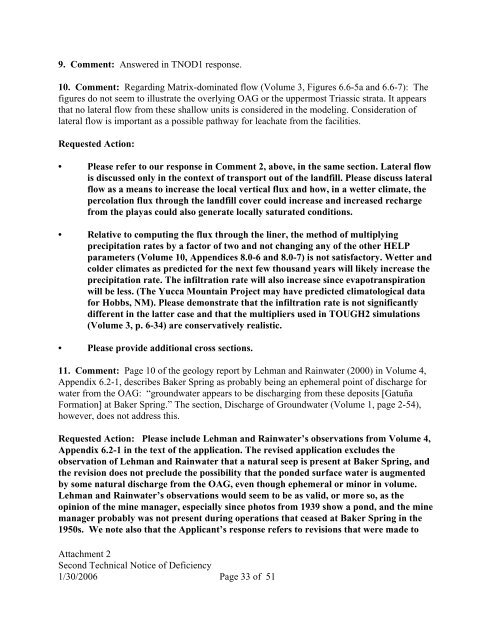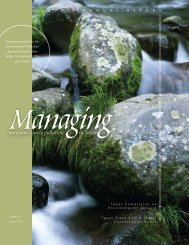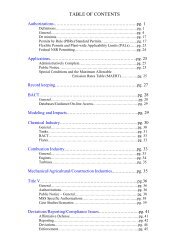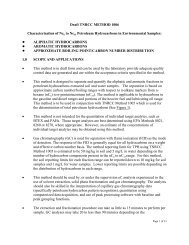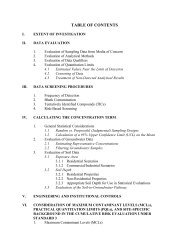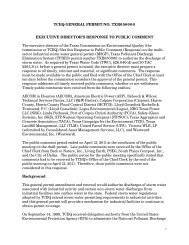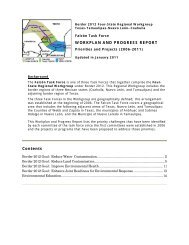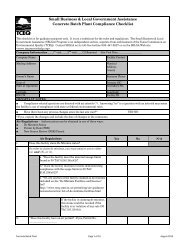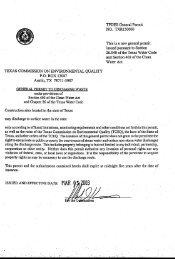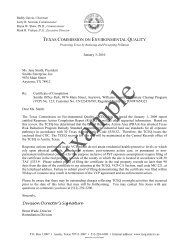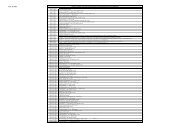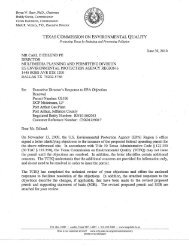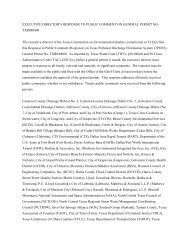texas commission on environmental quality - TCEQ e-Services
texas commission on environmental quality - TCEQ e-Services
texas commission on environmental quality - TCEQ e-Services
You also want an ePaper? Increase the reach of your titles
YUMPU automatically turns print PDFs into web optimized ePapers that Google loves.
9. Comment: Answered in TNOD1 resp<strong>on</strong>se.<br />
10. Comment: Regarding Matrix-dominated flow (Volume 3, Figures 6.6-5a and 6.6-7): The<br />
figures do not seem to illustrate the overlying OAG or the uppermost Triassic strata. It appears<br />
that no lateral flow from these shallow units is c<strong>on</strong>sidered in the modeling. C<strong>on</strong>siderati<strong>on</strong> of<br />
lateral flow is important as a possible pathway for leachate from the facilities.<br />
Requested Acti<strong>on</strong>:<br />
• Please refer to our resp<strong>on</strong>se in Comment 2, above, in the same secti<strong>on</strong>. Lateral flow<br />
is discussed <strong>on</strong>ly in the c<strong>on</strong>text of transport out of the landfill. Please discuss lateral<br />
flow as a means to increase the local vertical flux and how, in a wetter climate, the<br />
percolati<strong>on</strong> flux through the landfill cover could increase and increased recharge<br />
from the playas could also generate locally saturated c<strong>on</strong>diti<strong>on</strong>s.<br />
• Relative to computing the flux through the liner, the method of multiplying<br />
precipitati<strong>on</strong> rates by a factor of two and not changing any of the other HELP<br />
parameters (Volume 10, Appendices 8.0-6 and 8.0-7) is not satisfactory. Wetter and<br />
colder climates as predicted for the next few thousand years will likely increase the<br />
precipitati<strong>on</strong> rate. The infiltrati<strong>on</strong> rate will also increase since evapotranspirati<strong>on</strong><br />
will be less. (The Yucca Mountain Project may have predicted climatological data<br />
for Hobbs, NM). Please dem<strong>on</strong>strate that the infiltrati<strong>on</strong> rate is not significantly<br />
different in the latter case and that the multipliers used in TOUGH2 simulati<strong>on</strong>s<br />
(Volume 3, p. 6-34) are c<strong>on</strong>servatively realistic.<br />
• Please provide additi<strong>on</strong>al cross secti<strong>on</strong>s.<br />
11. Comment: Page 10 of the geology report by Lehman and Rainwater (2000) in Volume 4,<br />
Appendix 6.2-1, describes Baker Spring as probably being an ephemeral point of discharge for<br />
water from the OAG: “groundwater appears to be discharging from these deposits [Gatuña<br />
Formati<strong>on</strong>] at Baker Spring.” The secti<strong>on</strong>, Discharge of Groundwater (Volume 1, page 2-54),<br />
however, does not address this.<br />
Requested Acti<strong>on</strong>: Please include Lehman and Rainwater’s observati<strong>on</strong>s from Volume 4,<br />
Appendix 6.2-1 in the text of the applicati<strong>on</strong>. The revised applicati<strong>on</strong> excludes the<br />
observati<strong>on</strong> of Lehman and Rainwater that a natural seep is present at Baker Spring, and<br />
the revisi<strong>on</strong> does not preclude the possibility that the p<strong>on</strong>ded surface water is augmented<br />
by some natural discharge from the OAG, even though ephemeral or minor in volume.<br />
Lehman and Rainwater’s observati<strong>on</strong>s would seem to be as valid, or more so, as the<br />
opini<strong>on</strong> of the mine manager, especially since photos from 1939 show a p<strong>on</strong>d, and the mine<br />
manager probably was not present during operati<strong>on</strong>s that ceased at Baker Spring in the<br />
1950s. We note also that the Applicant’s resp<strong>on</strong>se refers to revisi<strong>on</strong>s that were made to<br />
Attachment 2<br />
Sec<strong>on</strong>d Technical Notice of Deficiency<br />
1/30/2006 Page 33 of 51


